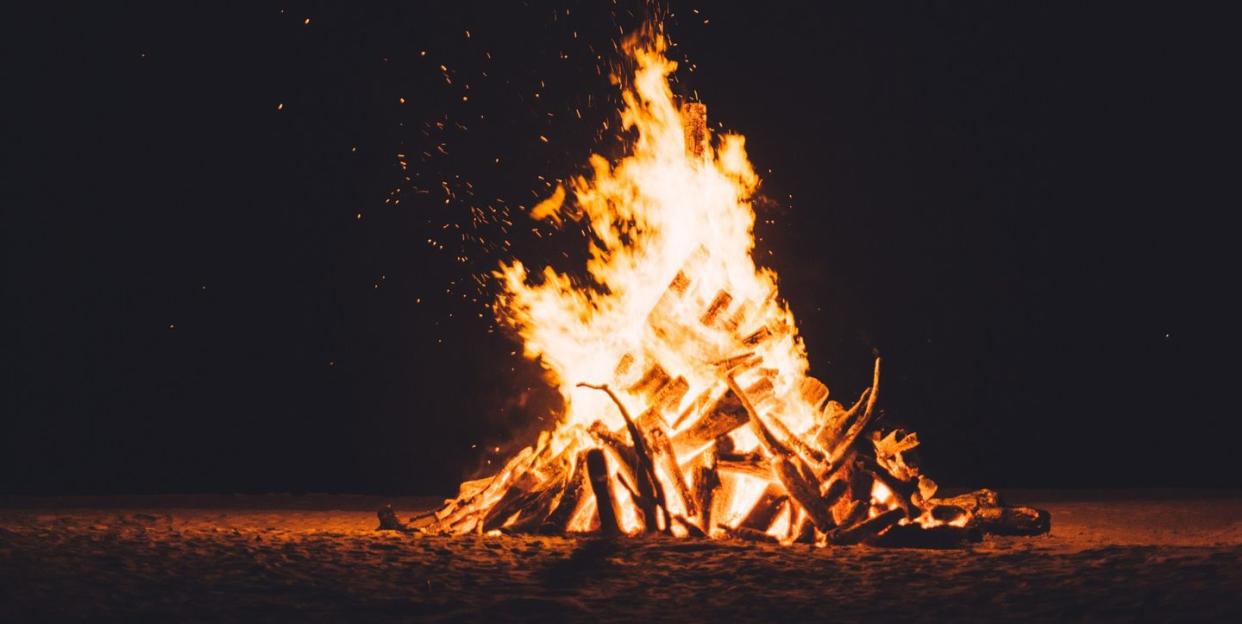How to Use Math to Build the Perfect Bonfire

"Hearst Magazines and Yahoo may earn commission or revenue on some items through the links below."
To build a good bonfire, you should stack your wood structure just as high as it is wide, like a pyramid.
This approach was first outlined in a 2015 paper published in Scientific Reports.
If you don’t have a fire pit, build your fire on soil or near a fire blanket.
While fire may be one of the oldest human technologies, building a bonfire—and keeping it safe—isn’t always an easy task. After collecting dry wood or twigs from around your campsite, you must decide how to arrange them for optimal burn. Is arranging them in a stack, like a log cabin, the right call? Or maybe just tossing them in a pile and seeing what happens?
In theory, there are innumerable ways you could arrange your fuel source, but according to Adrian Bejan, a professor of mechanical engineering at Duke University, there’s only one sure-fire way: your fuel should be stacked just as high as it is wide, like a pyramid. It’s no coincidence, Bejan says, that a pyre and a pyramid are so linguistically similar.
🔥 Science explains the world around us. We’ll help you make sense of it all—join Pop Mech Pro.
Even though this perfect solution has been hiding in plain sight for millennia, Bejan first laid out the mathematical formula for it in a 2015 paper in the journal Scientific Reports. “I was able to work it out as a homework problem for my students,” Bejan says. “It took about two hours one evening.”
Why Fire Is Like Swiss Cheese
The answer, he says, begins with understanding what kind of science dictates how fires burn. This is an extremely multifaceted question, but it comes down to two big contenders: thermodynamics and fluid dynamics.
“Thermodynamics is the science of power, [in this case] power from fire,” Bejan tells Popular Mechanics. “Which then is used to move things [like air] ... This air flow is feeding the combustion reaction and then the generated heat is convected away by the airflow itself.”
You can think of a fire kind of like a piece of Swiss cheese. In between different pieces of fuel (whether you’re using coal, wood, or another source), there are lots of holes or gaps that air can move through. If your fire is packed too densely, air can’t flow through to drive combustion; if your fuel is packed too loosely, then the air can’t get enough power to move quickly. The scientific term for this kind of hole-filled shape is a “porous medium,” Bejan says.
However, Bejan says that conical-shaped fires aren’t the only effective shape. As long as this width-to-height ratio is maintained, he says there’s no real limit to the shape of the fire. Too flat or too tall and the fire won’t be able to maintain its heat very long, or even get properly started.
Tips From a Firefighter
Understanding the mathematical principles behind the construction of a fire is only just the beginning, says Daniel Jimenez, a research engineer at the Missoula Fire Sciences Laboratory. After you build a fire, understanding the math at play to keep it safe—and effectively extinguish it—are crucial skills for not only firefighters, but nature enthusiasts as well.
As part of his job, Jimenez helps facilitate an online course to teach firefighters the mathematics behind the blazes they battle.
“Most of the math in our course is just basic geometry,” Jimenez tells Popular Mechanics. “But it does become a lot more advanced when you start thinking about volumes and pressures and [water] distribution systems.”
While some firefighters come to the career after college and have a background knowledge of physics and math, it’s also common for others to become firefighters straight out of high school, Jimenez says. This online course helps provide a common ground of science- and math-based knowledge to keep the firefighters safe and sharp on the job.
Jimenez also designs mathematical modeling software to help firefighters keep track of evolving wildfires. These app- and computer-based softwares can include landscape and wind modeling and replace what used to be physical pocket-size guides. This helps firefighters not only contain blazes but also do safe, prescribed burns that can help prevent uncontrolled blazes later in the season.
As for how to keep your mathematically-perfect campfire safe, Jimenez says the answer is pretty straightforward: containment. An excellent way to ensure your fire won’t accidentally spread beyond its base is to make sure its fuel source is discontinuous, Jimenez says, meaning there isn’t stray fuel near the fire.
A metal fire pit is one easy way to do this or you can build your fire on soil or near a fire blanket. And before you leave your fire, make sure to shut down the thermodynamics at work with a good dousing of water.
“If I had any advice for anybody with campfires it would be to drown them,” Jimenez says. “You can’t put too much water on a campfire.”
You Might Also Like
